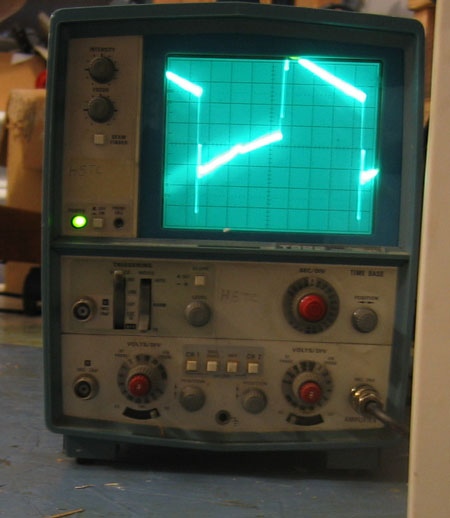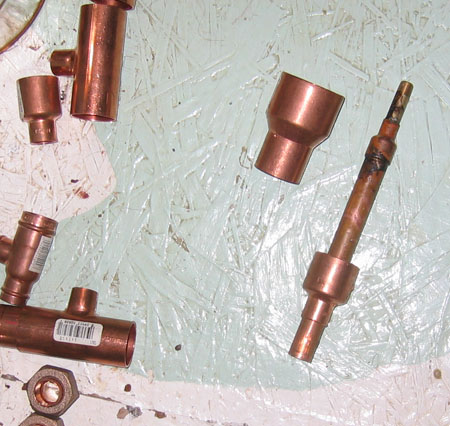|
|
|
sprawling impromptu puzzle
Sunday, January 14 2007
My mother turned seventy today. Seventy is the new fifty, just like going out through the in door is the new English Muffin.
That idea of adding multiple sliding trays to my computer desk (which I mentioned yesterday) is a grand ambition for some day down the road. A more immediate interest is to add easy-to-access features to my Atmel prototyping board. These might include a speaker with an audio amplifier and perhaps an LCD display. I've always had interest in flexible electronic experimentation environments; I still have one of those electronic kits with the little springs you bend to the side to wire up an AM transmitter or a siren sound effect generator. Such environments come in handy when you want to explore an electronic device using several different senses, the kind that are completely outside the familiar human variety.
One of those senses is displayed visually by an oscilloscope. It gives a visual sense of the changes in voltage, even when those changes take place over the course of a microsecond. I have an oscilloscope, but I haven't really used it since buying it on eBay. I'd had an old tube-based oscilloscope I'd dumpster-dived from UVA and could use it, but it was comparatively simple. This one is a dual-trace model, and its behavior is complicated by several staticky potentiometer controls. This morning, though, I managed to figure out how to display a 776 kHz signal generated by some code on an Atmega168 on my Atmel prototyping board. Strangely, the waveform was skewed far out of square, manifesting its highest point immediately upon switching high and then gradually fading to nearly a low state before switching radically low and then quickly rebounding to a reasonable low. During all the reasonably stable periods, the waveform would oscillate slightly at a high speed that looked to be about the clock speed of the microcontroller, 16 MHz.

I spent a lot of time today working on a copper chandelier for the dining room. The goal is to replace a Navaho-style tiffany light fixture we've had since shortly after moving in with something completely original. The tiffany light is an okay fixture but for such an important socializing spot something completely custom would be better.
Over the past few weeks I'd gradually determined how to fit together the various parts for the chandelier, which had turned into a sprawling impromptu puzzle. I'd decided to use small-socket (G 16.5) 120 volt bulbs, and I'd discovered that there exists a kind of socket for this bulb that can be screwed onto the end of a 1/4 inch brass plumbing nipple. And such nipples can, if lathed slightly in a drill press, be inserted into the small end of a 1/4 to 1/2 inch copper fitting. To create a surround for the socket, I could use a 1/2 inch to inch fitting attached to an inch to inch and a half fitting. By filing off the insertion stops from that 1/2 inch to inch fitting, I could run a piece of half inch copper pipe right through it, attach the 1/4 to 1/2 inch copper fitting on its tip, and then include the 1/4 inch brass nipple, creating a node of the chandelier. If this is too complex to visualize, I have a picture to help you.

Here you can see a length of half-inch pipe tipped with a half-to-1/4 inch fitting ending with a lathed brass nipple. A third of the way from the bottom of the half inch pipe you can see a half-to-inch fitting. It's had its stops filed off so the half inch pipe can pass right through it. Ultimately it will be slid up to the top and that big inch-to-inch-and-a-half fitting you see lying nearby will be attached to it to create something resembling a copper flashlight.
I ended up building six such chandelier nodes, each at the end of an arm bent at a right angle, each arm having a different-lengthed "humerus" to allow them to be arranged without interfering with each other. Ultimately the plan was to use union fittings to hang these arms off a vertical axis of interlocking (but unsoldered) copper fittings, permitting the arms to rotate in two different planes. Since this central axis would be a stack of unsoldered fittings, I'd need something running through the middle of them to keep them attached to the ceiling. In the end I went with a piece of six gauge steel wire which had once (in 2004) served as the framework for a political yard sign. I soldered the threads from a quarter inch brass nipple to both ends of this wire, allowing it to screw into a support system in the ceiling at one end and a nub at the other (something to keep the fittings from sliding off the wire's end). (The reason I didn't just use a piece of quarter-inch threaded steel was that I'd made the central axis from inch-wide fittings, but I needed as much of that cross section as I could get to accommodate wire nuts.)
This evening Gretchen and I went out to dinner at a friend's house. On the way we listened to a greatest hits CD of a band called 10cc, which Gretchen had bought just for one song she'd heard on the oldies station, "I'm Not In Love." (For some reason it had proved impossible to obtain from the file sharing networks.) 10cc is a mid-70s band that usually sounds a lot like Queen and a little like ELO, though they also anticipate modern bands such as Red Hot Chili Peppers and Super Furry Animals. Unfortunately, though, most of their songs are absolutely dreadful, giving the Bohemian Rhapsody treatment to some idea that shouldn't have survived the most cursory of morning-after reassessments.
[REDACTED]
For linking purposes this article's URL is:
http://asecular.com/blog.php?070114 feedback
previous | next |

